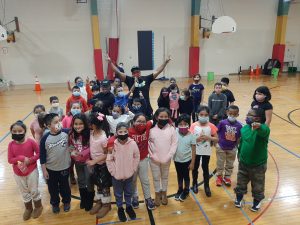The Expansion of the Rhythm Program
Previously, I had spoken with Oscar Hawthorne, the Deputy Superintendent of North Chicago, about the Rhythm Program- a social emotional and culturally relevant dance program being taught to the students in this district. During today’s interview, we talked more about the expansion of the Rhythm program and how important programs like these are for students.
What programs did you have in place prior to the Rhythm program?
There were no programs like the Rhythm p
rogram in place beforehand. We mainly relied on the health and wellness curriculum. Rhythm was presented to us, and it was a unique program that engaged students to dance. It was originally for young ladies, but now young men and non-binary students are welcomed to join as well. With the Rhythm program came the addition of the King in me program being added. The King in Me program was a minor program

before Covid and couldn’t flow via pandemic because of the in-person component. The King in Me program was eventually merged with the Rhythm program.
Tell me more about the Rhythm program and how it affected the student’s well-being during the pandemic.
One of the interests for students is dance, which is very popular. Rhythm has proven to be a wonderful outlet for young people returning to school with SEL challenges, due to the pandemic. The program provides an opportunity for expression as well as an SEL component. It allows the students to talk amongst each other and share their own personal success stories. It also encourages good morals and values and how to be a good person outside of the typical classroom setting.
The last time we spoke, you mentioned how the program was expanding. Can you talk more about the program’s expansion and growth?
Last year it was difficult to try and benchmark a consistent number of students with remote, then hybrid learning. Half of the students remained remote throughout. Now that we are back in-person, there has been substantial growth. We originally budgeted for 50 students per school, for each of the three schools. We would take 1 group per quarter for a total of four quarters. Growth began in the second quarter. The number has grown to over 70 students per quarter for the following two quarters. All of the participating schools now have a waiting list for the program. The contract has been revised to allow for extra time as well as additional social distancing to align with covid safety guidelines.
What are the students saying about the program?
In my interactions with principals, the students really love to dance, and it is going to blossom into something where they will have to think about how they will incorporate this at the high-school level in the future. The students want to dance. They want more opportunities outside of the school day- especially for high-school and middle-school.
Tell me how funding from AFHK has helped the program’s success.
The support from AFHK is appreciated. We are always looking for ways to expand well-being programs for students. There are limitations but AFHK has provided the opportunity to use time outside of the typical school day and class structure with the opportunity to engage in a different environment, with different members of the community. Some of the dancers that come out are local and some of the families know the instructors. Instructors are locals and people of color which resonates with the students.
Categories: Elementary School, People Taking Action, Illinois